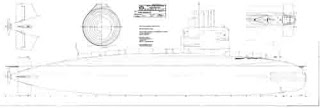The Nautilus by Robert Fulton, 1800 (USA) [Francis]. In 1800 Fulton obtained a grant to build the sub for Napoleon.

The 'Brandtaucher' designed by Wilhelm Bauer in 1850
The 'Hunley', after Horace Lawson Hunley, 1863 (USA) [Ragan, 1995]. An American human powered submarine. The Hunley took part in the civil war and was the first submarine ever that sunk an enemy vessel on February 17th, 1864. Currently the wreck of the Hunley has been salvaged.

An early submarine design by John P. Holland, 1877 (USA) [Morris, 1998]. The text on the drawing states that the boat was experimented with in 1878 and contains the autograph of John Holland!

Design by George Garrett, 1878(UK) [Compton-Hall, 1999]

The 'Nautilus' by Ash and Campbell 1888 (UK) [van der Vat, 1994]. This boat was the first to run on batteries underwater.
Holland A-1 design, 1901 (USA) [Chant, 1996]. This boat may be regarded as the first real submarine. It features diesel electric propulsion and has on board torpedo tubes. The life and works of John P. Holland, is outlined in [Morris, 1998].
The first true German U-boot: the U1 1906

O1. The first Royal Dutch Navy submarine, 1906 (NL) [Jalhay, 1997].

K-18. Pre WWII Dutch submarine 1931 (NL) [Wytema, 1936]
Type II German Pre WWII submarine, 1935
Type 9b German pre WWII submarine, 1939

Type VIIB German WWII submarine, 1939

German Type XIV, WWII submarine, 1940 (D). The XIV supplied fluel to other submarines and was thus called a milkcow

Famous German WWII boat Type VIIC, 1941

British Chariot Mk I, 1942 (UK). A two person human manned torpedo.

An English WWII mini submarine X-craft, 1942 (UK). X5-X10 series. [Kemp, 1999].
Russian Quebec class submarine, 19XX (USSR).

Zulu V class Russian submarine, 1952

Russian November Class submarine, 1958 (USSR).

Typhoon, Russian missile submarine 1980 (USSR) [Modeler Konstruktor]. Thanks to Jerome Simon, who is building this boat.
TR 1700 Argentinan submarine, 1980.
Akula, Russian submarine 1984

Norwegian Ula class, 1989

Russian Oscar II Class 1990

British Vanguard Class 1992

Turkish Preveze Class (German design 209-1400) 1994 (T)

Source : heiszwolf
Also This







































